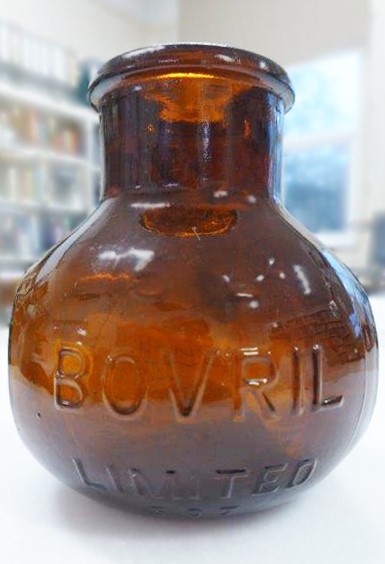This is a Bovril jar, it is one of 150,000 objects that make up Bucks County Museum’s collection. It is made of brown glass with a round bottom that has two straight sides. It narrows at the top but the neck is still wide enough to fit in a tablespoon. The glass is opaque but there is a hint of transparency and on the front of the jar, the glass pops out to spell Bovril Limited.
Bovril was a popular protein enriched beef extract. It is a thick gloopy substance which was commonly diluted in hot water to make a hot beef tea. It could also be added to stews and soups. It is a glossy black colour and smells somewhere between dark chocolate, ground coffee and tobacco. Whilst it is not so common nowadays, it is still sold in many countries.
It was adored by the young and the old. Many football supporters in Britain were seen drinking it in stadiums from their thermoses to keep warm during half time. It was sold in pubs, chemists and stores. Roald Dahl’s character Matilda even enjoyed a mug of Bovril occasionally whilst reading books.
It was also sent to troops during wars to help them regain their energy. Bovril was used as a remedy by mothers, nurses and even prescribed by doctors. It was said to develop strength.
The branding of Bovril played a big part in sending out this message, adverts for the drink were constantly linked to strength and masculinity. Posters frequently showed images of a strong bull. Pictures of army men drinking Bovril were published.
Bovril wasn’t always called Bovril, it used to be called ‘Johnson’s Fluid Beef’. It was invented by a Scotsman, John Lawson Johnson in 1886. Johnson came up with the idea when Napoleon III ordered 1 millions cans of beef for his army men. The first part of the word, ‘bo’ comes from ‘bos’ meaning beef in Latin and was combined with ‘vril’ meaning electric fluid. Together it became a popular household name.
The Bucks County Museum takes this distinctive jar along with other objects to care homes to deliver reminiscent sessions for residents, some with dementia. It brings back a lot of memories for older people who used to commonly drink this meaty drink.




